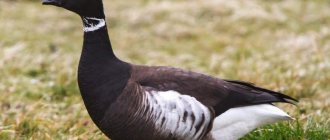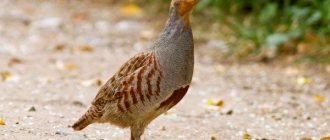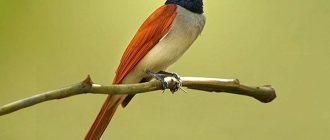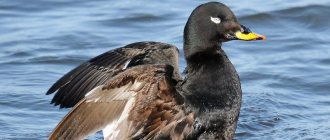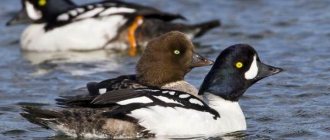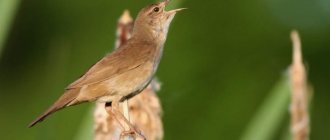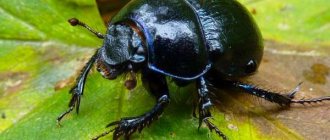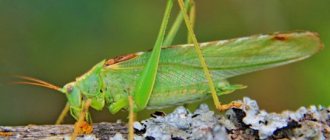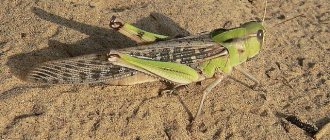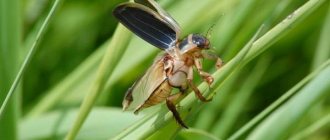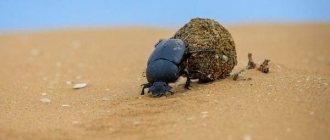| Latin name | Anser fabalis |
| English name | Bean Goose |
| Squad | Anseriformes |
| Family | Duck |
| Body length, cm | 65-90 |
| Wingspan, cm | 140-190 |
| Body weight, kg | Average – 2.8-3.4 |
| Features | Compared to other types of greylag geese, the bird has darker plumage, orange legs and a dark head and neck. |
| Number | 680,000-800,000 individuals |
| Security status | Least Concern (decreasing). |
| Habitats | Lakes, ponds, rivers, streams. |
| Additionally | Research shows that bean goose birds nest at a distance of at least 65 m from other geese. |
- 4.1 Range
Description
The bean goose is a feathered representative of the duck family. It is similar to the eastern tundra goose (Anser serrirostris), but smaller in size, with a shorter beak. The description of the bean goose species says that the bird is divided into several subspecies: Anser fabalis, Anser serrirostris, Anser middendorffii, Anser rossicus, Anser johanseni.
— Advertising —
The breeding grounds of the feathered representatives are located in the Northern Palearctic, and wintering grounds extend from Europe, Iran, China, Korea and Japan to Southeast Asia. The birds often visit large rivers and lakes and are also found in lowlands.
Bean beetles feed on plant materials, including leaves, tubers and seeds of various plant species. Feathered representatives are monogamous, as they maintain a connection with their partner for life. Both adults share nesting duties.
The bean goose is threatened by habitat degradation, pesticide poisoning and climate change in its breeding areas. The bird's population is declining, but today the species is not endangered.
Number
The global population of the bean goose is estimated at 680,000-800,000 individuals, but there is a general downward trend in the population.
Structure and dimensions
— Advertising —
The physical description of the species is generally common to each subspecies, with the exception of coloration, beak size, and body length. The largest subspecies is A. f. middendorffii - from 75 to 90 cm long, the smallest is A. f. rossicus - about 65-80 cm. The wingspan varies from 140 to 190 cm. The weight of the female bean goose is about 2.8 kg, the male - about 3.4 kg.
All subspecies have a brown head and back and a light brown neck and chest. The belly is white, with pale brown lines on the chest. The tips of the brown wing feathers are edged with white, creating the appearance of a stripe along the back. The goose's legs are orange.
Beaks differ among subspecies. The three subspecies Anser fabalis, Anser fabalis middendorffii and Anser fabalis johanseni have long, black bills with an orange stripe over the upper jaw, although the color is duller in the latter two. The bill of Anser rossicus is shorter and thicker, with an orange patch on the upper jaw. Anser serrirostris has a long, black bill with several orange stripes.
The female and male have the same plumage, but the latter is larger in size.
The young are similar to adults, but with a paler body color.
Why is a goose so valuable?
As mentioned above, the goose has many advantages.
Goose meat may well be considered dietary. All fat accumulates directly under the skin. Muscle mass contains amino acids, beneficial vitamins and minerals. Goose by-products are easily digestible and have a delicate and pleasant taste. Goose fat also has many beneficial properties. For burns, you need to apply melted goose fat, and this will help restore the skin. If you have a cough or inflammation of the bronchi, you can rub goose fat on your chest and back. You can make pillows, blankets, and outerwear from goose feathers. What different types of geese look like was discussed in detail in the article. From ancient times to this day, this bird has benefited humans.
Behavior
A distinctive behavior observed in geese is aggression when defending their home territory. It is expressed through three neck positions: straight, diagonal and forward. An upright neck posture is often observed in Anser species and is accompanied by shaking of the neck feathers. At the same time, sometimes birds flap their wings, but in most species they are not fully extended.
In addition to aggression, the scientific literature describes other behavioral features of the bean goose, which differ between subspecies. For example, Anser fabalis is calmer than Anser fabalis rossicus, which is represented as "nervous".
Character and lifestyle
Being a waterfowl, the bean goose bird is at the same time not strongly attached to the aquatic environment. They usually swim in the evening, and spend the whole day on land, where they feel simply excellent, moving quickly and jumping among the meadows.
And even if danger arises, bean goosefish are more likely to take off in a swift flight than to rush into the water for salvation, despite the fact that they feel free there, swimming and diving well.
These birds molt only once a year, and this usually happens during the period of raising chicks. At such moments, birds strive to move with their cubs to remote and rather inaccessible places, mainly choosing meadows with short grass for their placement.
At the same time, the birds try to stay in large flocks, and their habitats, as a rule, are jealously guarded by goose guards. Young individuals begin to molt first, and this process occurs somewhat later in more mature birds.
Habitat
In spring, birds are found in cold biomes near swamps and lakes, especially in the tundra and taiga. During the winter, this species often visits large fields, agricultural lands, lakes and swamps. Subspecies A. f. johanseni and A. f. serrirostris are found near lakes and swamps more often than others.
Habitat: temperate, terrestrial, freshwater.
Terrestrial biomes: tundra, taiga.
Aquatic biomes: lakes, ponds, rivers and streams.
Wetlands: marsh bog.
Other habitat features: suburban, agricultural, coastal.
Area
The bird is found in parts of Europe and Asia. The habitat features of the bean goose species are as follows:
- Af fabalis breeds from Scandinavia to the Ural Mountains. Winters in western and southeastern Europe, as well as in southeastern Asia.
- Af johanseni breeds from the Ural Mountains to Lake Baikal. Winters in Turkmenistan and Iran, in eastern China. This subspecies is intermediate between fabalis and middendorffii.
- Af middendorffii breeds in Siberia and also on Lake Baikal. Winters from China to Japan. Overall, this subspecies is larger, with a longer neck, legs, and thin beak.
Nutrition
Like any animal, geese have nutritional needs. Birds require a diet similar to ducks, but there are important differences:
- The goose's digestive tract has adaptations that help the bird digest high-fiber foods.
- The stomachs of individuals are capable of grinding food better than duck or chicken.
- Geese that have evolved to prefer leaves and roots have shorter and narrower beaks. Such beaks help birds grab food more tightly to trim tough parts of the plant.
Birds should receive the following nutrients from their food:
- Protein (amino acids). Geese, like other birds, do not actually need “protein”, but individual amino acids found in food proteins. Proteins are broken down during digestion into amino acids, which are absorbed and used by geese to make their own body proteins, such as in muscles and feathers.
- Grains. Grains include the small seeds of the durum grass family, such as oats, corn and wheat. They provide vitamin B, vitamin E and phosphorus.
- Greenery. Among their many benefits, fresh greens contain vitamin E, essential for a strong immune system, as well as riboflavin, vitamin A and calcium.
- Niacin – Vitamin B5. Participates in metabolic reactions for the synthesis and breakdown of carbohydrates, fats and proteins. Its deficiency leads to disruptions in the process of glucose formation, the citric acid cycle, the respiratory process chain and other important functions.
- Vitamin A. A lack of vitamin in the diet leads to stunted growth of goslings, causes loss of coordination, drowsiness, ruffled feathers, weakness, deterioration in the absorption of nutrients, and so on.
- Vitamin D. Deficiency of this vitamin causes the development of rickets in young birds.
The preferred food that satisfies these needs is: green grass, corn, rice, barley, wheat, soybeans, tuberous potatoes, sugar beets.
There are a number of plants and human foods that are dangerous to the species. These include:
- Avocado – contains the toxin persin.
- White potatoes contain solanine.
- Green tomato and tomato leaves contain solanine.
- Eggplant and pepper leaves contain solanine.
- Green potatoes contain solanine.
- Apple, apricot, cherry, peach, pear, plum seeds/pits – cyanide.
- Rhubarb – oxalic acid, which leads to softening of the egg shell.
- Dried beans, raw and leguminous plants - phytohemagglutinin.
- Raw peanuts, hazelnuts, walnuts and pecans interfere with protein absorption.
- Onions – thiosulfate toxin.
- Chocolate is theobromine.
- Processed foods for humans, especially those that are fatty, salty or sweet.
- Anything that is sprayed with pesticides or herbicides.
There are a number of plant species that are poisonous to the bean gooseberry:
- Azalea.
- Beans.
- Sterlicia or Royal flower.
- Dicentra.
- Buttercup.
- Lobelia purpurea.
- Clematis or Prince.
- Coriander.
- Datura.
- Larkspur.
- Dieffenbachia.
- Elderberry.
- English ivy.
- Night beauty, or Mirabilis jalapa, or Mirabilis laxative.
- Foxglove or Digitalis.
- Heliotrope.
- Spotted hemlock.
- Holly or holly.
- Honeysuckle.
- Horse chestnut.
- False pepper nightshade.
- Juniper.
- Lupine or wolf bean.
- Vatochnik or Asklepias.
- Mistletoe.
- Chubushnik.
- Wolfsbane or Fighter.
- Morning glow.
- Mushrooms (some).
- Nightshade.
- Toxicodendron or Mustard.
- Parsley.
- Rapeseed.
- Rhubarb, leaves.
- Sorghum, grass.
Basic rules for keeping pets
Feeding
It has long been noted that geese living on free grazing live longer than birds constantly kept indoors. During walks, birds feed themselves with natural food rich in useful and nutritious substances.
Additional complementary foods include combined feeds, boiled vegetables, cottage cheese, sprouted grains, feed yeast, fish oil, cake, additives with a high content of mineral elements: meat and bone and fish meal, crushed shells, chalk.
It is recommended to adjust the composition of the feed depending on the season, the period of laying and hatching of chicks. Constant access to fresh food is desirable. How to create a menu correctly, read the article “What to feed geese from the first days of life at home.”
Summer content
It is widely believed that for a fruitful breeding of domestic geese, it is necessary to have a body of water near their residence. For example, Kholmogory ganders swim even in icy water.
However, this is a convention. A homemade font with regularly fresh water is often sufficient. How to make it can be seen using the example of the article “Building a pond for ducks on a summer cottage with your own hands.” The information is also relevant for geese.
In the summer, the birds do without a gooseneck and spend the night well in an open enclosure. Its area is calculated based on the number of birds: 1 sq. m. for 2-3 birds. The enclosure area is equipped with feeders and drinking bowls. During the day, it is recommended to release the birds to free grazing. The area of the walking area is at least 5 square meters. m. for 1 individual.
Winter content
In winter, the birds are transferred to the goose barn. Area: 2 sq. m. for 3 individuals. The room should be draft-free, with sufficient fresh air to prevent fungal deposits. Straw mixed with sawdust is laid on the floor. What else you need to know about the poultry house, read the article “Building a barn for geese with your own hands.”
In a goose shed, periodic sanitary treatment of walls and floors with lime mortar and regular replacement of bedding material are required. Sand, gravel, shells and chalk are poured near the feeders.
Hatching of offspring
For 3-4 geese it is enough to keep 1 gander. Geese lay eggs in February-March. At this time, additional lighting is needed to maintain daylight hours up to 14 hours, and insulation of the masonry areas. For 2-3 individuals, 1 nest is installed, the construction of which is described in the article “How to make a nest for geese with your own hands.”
Particular attention is paid to newborn and young goslings. A separate clean room is allocated for their maintenance, the temperature is not lower than 16-18 degrees
Routine vaccinations will help protect birds from viral and infectious diseases. At the first signs of illness (loss of weight and appetite, lethargy), you should consult a veterinarian.
Reproduction
Courtship takes place over several weeks. These include flights of three or four birds together, as well as the display of tail feathers while swimming.
When a future partner is chosen, a "triumph ceremony" is performed by both members of the couple. At this time, birds in the Anser genus stretch their necks and approach each other. This is initiated by the man after he has chased away the remaining competitors. The ceremony can be held annually throughout the life of these birds, as a way to renew kinship ties and strengthen family relationships. Often young animals participate in this ritual with their parents.
The species reproduces annually, and pairs raise their young together. The mating season begins in May-June, but clutches depend on weather conditions.
The gooseberry nests on the ground, 50-100 centimeters above its surface, in hummocks protected from flooding. Birds build a nest from vegetation that they find in the immediate vicinity of the nesting site. Bean beetles lay 4 to 6 eggs, which incubate for 27 to 29 days.
Scientific research says that sometimes single parents breed broods.
Choosing a place to hunt a goose
Any goose hunt begins with choosing a place for future hunting. When hunting a goose in an organized hunting area, the rangers of this hunting area have already scouted out the roosting areas for the geese, set up blinds and placed stuffed animals; all you have to do is come to the hunt, sit in the blind and wait for the geese to fly. When hunting on your own, you will have to do everything yourself, including looking for a place for future hunting.
In order to find and choose a place for goose hunting you will have to spend from one to several days. You need to start searching for a place for goose hunting by interviewing local residents, rangers, hunters, and fishermen. You need to ask them if they have seen geese sitting on the field or flying at low altitude, preparing to land on the ground.
After such questions, you get behind the wheel of a car, preferably an SUV, and drive around fields, meadows, and swampy lowlands in search of flocks of geese. Be sure to take hunting binoculars with you, they will be very useful for such reconnaissance. Look for geese feeding in the field, birds coming to land, new flocks of geese approaching geese sitting on the ground.
You can find the place where geese are supposed to feed by looking at fresh goose droppings left on the ground and traces of goose paws imprinted on the ground. Such a place for goose feeding is constantly visited by geese; in the morning the geese will fly to the same place. Having decided on the hunting location, you need to install ready-made ones or make them right on the goose hunting site.
Wintering
The bean goose is conventionally divided into four subgroups, depending on breeding and wintering areas:
- The western group includes birds that breed in central Scandinavia and winter almost exclusively in the United Kingdom and northern Denmark. A small number of individuals may also winter in Norway and Sweden.
- The central part of the birds covers breeding areas in northern Sweden, northern and central Finland, north-eastern Norway and the Russian Federation. These feathered representatives winter in Denmark, Germany, the Netherlands and southern Sweden.
- The eastern part of the breed breeds in the Russian Federation. Bean beetles migrate through Belarus, Estonia, Latvia, Lithuania and Ukraine for the winter in Germany, the Netherlands, Poland and, in small numbers, in southern Sweden.
- Little is known about birds from the conventional East Asian group. The goose's breeding area is believed to be located in the eastern part of western Siberia, with wintering grounds in Kazakhstan, Kyrgyzstan and northwestern China.
Migration
The wild bean goose migrates in flocks, often in long V-shaped lines. It occurs from late August, although in greatest numbers in October. The bean goose returns back in the spring: March, April, May. Most birds migrate to wintering areas around the North Sea or, in recent years, to southern Sweden and Denmark.
Photo gallery
We invite you to look at the photos of birds provided in our photo gallery.
Huge flock of grazing bean goats
Bean mushrooms on the evening field
Gooseberry - hunter's trophy
Gooseberry in the Red Book
The species is considered Least Concern on the International Union for Conservation of Nature and Natural Resources Red List, although reports indicate populations may be declining.
The Royal Society for the Protection of Birds in Great Britain describes A. f. fabalis as the "red" subspecies and A. f. rossicus, as in "amber". The red species are those of greatest conservation concern, with a marked reduction in breeding range. Amber-listed species are experiencing moderate declines or may be extremely limited. Anser f. rossicus is listed as such due to low numbers of breeding populations.
The International Union for Conservation of Nature and Natural Resources' Red List lists threats to the bird. These include habitat modification or degradation, i.e. loss of wetlands, drainage of lakes, pollution, i.e. oil spills, and pesticides targeting agricultural pests.
The bean goose is listed in the Red Books of the Russian Federation and Ukraine.
Nutritional qualities of wild goose
Wild goose meat is dark in color and has a greasy texture. Due to the predominance of natural plant foods in the poultry diet, the meat has a unique aroma with a sweet aftertaste.
For many years, culinary experts have been coming up with a variety of dishes with goose meat. It is perfect for preparing rich broths, baking and frying.
Goose meat has great nutritional value due to its impressive content of high-quality protein. Goose meat also contains the necessary vitamins (A and C) and minerals for the proper development of the human body. Goose meat promotes the active production of bile and strengthens the walls of blood vessels.
There are many types of wild geese. They are all unique, and our article helps to understand in more detail their habitat, feeding and nesting. And useful recommendations will allow you to properly domesticate the bird.
Interesting Facts
- The gray bean goose aggressively defends its territory and exhibits three neck postures such as upright, diagonal and forward. The latter position often signals an upcoming fight.
- The bean fly has a straight flight with powerful, stable wing beats.
- The English and scientific names of the species come from the bird's habit of grazing in legume fields during the winter. Anser is Latin for goose, and fabalis comes from the Latin faba, meaning beans.
- The European Bird Age Database reports that the oldest bean goose found was 25 years and 7 months old.
- Müller et al (1999) found that bean goose and white-fronted geese spread the Avulavirus, which causes Newcastle disease. The disease is transmitted to wild and domestic birds, as well as to people.
- In 2008, scientists discovered that this bird species is a temporary host for cryptosporidium - Cryptosporidium and intestinal giardia - Giardia duodenalis. Both of these parasites have effects on the human body.
- Additional parasites found in bean goosebumps include the nematode Epomidiostomum crami and the parasitic helminth Amidostomum anseris.
- The negative impact of the species on the economy is the loss of crops by farmers due to geese grazing in the fields during the winter months.
- During stormy winds, feathered representatives seek refuge in reed hollows, where they are difficult to detect.
- The name of the largest subspecies of bird A. f. middendorffii in different languages of the world: German – middendorsaatgans; French – oie des moissons; Italian – oca granaiola di middendorf; Japanese – o-hishikui; Dutch – middendorffs rietgans; Slovak – hus tajgová.
- The girl plucks her own feathers and adds them to the nesting material so that the future nest will be warm and cozy for the babies.
- Adult geese molt in 2 stages. Feathers begin to change in the summer and end in the fall. Birds do not fly during molting.
- Water rolls off the bird's feathers, as they are covered with a special wax-fat layer. This is where the expression “water off a duck’s back” comes from.
- The bean bird was considered a sacred animal in ancient Greece and was kept as a pet.
- The mass of geese feathers is greater than their bone mass.
- The bean bean's heart beats about 900-950 times per minute during flight and about 390 times per minute during rest.
